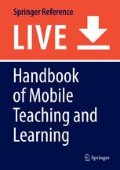Abstract
The percentage of people who have access to technological devices has proliferated, which, in turn, has expanded the utility and accessibly of mobile devices for both noneducational and educational purposes. Despite the Joint Information Systems Committee’s (JISC 2011) call for systematic evaluations of mobile learning initiatives almost a decade ago, evaluation projects that take a systematic approach at determining the value of mobile learning are scarce. More knowledge is needed to better understand the organizational support needed for their successful deployment, how to operationalize fidelity of implementation when unintended consequences transpire, and how best to measure the impact of mobility on learning. The chapters in this section entitled “Evaluation of Mobile Teaching and Learning Projects, an Introduction” begin to tackle these issues by articulating the myriad of issues to consider when evaluating mobile learning initiatives in education. These evaluations are primarily positioned in higher education but also span K-12 and informal settings. Taken together, these chapters exhibit the necessity for evaluations to focus on the technology, the user, and the context. Also, the chapters accentuate evaluating the mobility of the person and the learning process, rather than the mobility of the device, per se.
References
Bano, M., D. Zowgi, M. Kearney, S. Schuck, and P. Aubusson. 2018. Mobile learning for science and mathematics school education: A systematic review of empirical evidence. Computers & Education 121: 30–58.
Crompton, H., and D. Burke. 2018. The use of mobile learning in higher education: A systematic review. Computers & Education 123: 53–64.
Crompton, H., D. Burke, and K.H. Gregory. 2017. The use of mobile learning in PK-12 education: A systematic review. Computers & Education 110: 51–63.
Eliasson, J., T. Pargman, J. Nouri, D. Spikol, and R. Ramberg. 2011. Mobile devices as support rather than distraction for mobile learners: Evaluating guidelines for design. International Journal of Mobile and Blended Learning 3 (2): 1–15.
JISC InfoNet. 2011. Mobile learning infoKit. Retrieved from: https://2020research.files.wordpress.com/2011/07/mobile-learning-infokit.pdf
Levene, J., and H. Seabury. 2015. Evaluation of mobile learning: Current research and implications for instructional designers. TechTrends 59 (6): 46–52.
Moore, R. 2018. Smartphones and laptops are the most accessible technological devices students have at home. Iowa City: ACT. https://www.act.org/content/dam/act/unsecured/documents/R1680-tech-devices-at-home-2018-05.pdf.
Moore, R., and D. Vitale. 2018. High school students’ access to and use of technology at home and in school. Iowa City: ACT. https://www.act.org/content/dam/act/unsecured/documents/R1692-tech-device-access-2018-07.pdf.
Moore, R., D. Vitale, and N. Stawinoga. 2018. The digital divide and educational equity: A look at students with very limited access to electronic devices at home. Iowa City: ACT.
Motiwalla, L.F. 2007. Mobile learning: A framework and evaluation. Computers & Education 49: 581–596.
Park, Y. 2011. A pedagogical framework for mobile learning: Categorizing educational applications of mobile technologies into four types. International Review of Research in Open and Distance Learning 12 (2): 78–102.
Pew Research Center. 2017. Mobile fact sheet. https://www.pewinternet.org/fact-sheet/mobile/
Purcell, K., Al. Heaps, J. Buchanan, and L. Friedrich. 2013. How teachers are using technology at home and in their classrooms. Washington, DC: Pew Research Center. http://www.pewinternet.org/2013/02/28/how-teachers-are-using-technology-at-home-and-in-their-classrooms/.
Sharples, M. 2009. Methods for evaluating mobile learning. In Researching mobile learning: Frameworks, tools, and research designs, ed. G.N. Vavoula, N. Pachler, and A. Kukulska-Hulme, 17–39. Oxford: Peter Lang Publishing Group.
Sharples, M., J. Taylor, and G. Vavoula. 2007. A theory of learning for the mobile age. In The sage handbook of eLearning research, ed. R. Andrews and C. Haythronthwaite, 221–247. London: Sage.
Suarez, A., M. Spechter, F. Prinsen, M. Kalz, and S. Ternier. 2018. A review of the types of mobile activities in mobile inquiry – Based learning. Computers & Education 118: 38–55.
Sung, Y., K. Chang, and T. Liu. 2016. The effects of integrating mobile devices with teaching and learning on students’ eLearning performance: A meta-analysis and research synthesis. Computers & Education 94: 252–275.
Vavoula, G., and M. Sharples. 2009. Meeting the challenges in evaluating mobile learning: A 3-level evaluation framework. International Journal of Mobile and Blended Learning 1 (2): 1–22.
Wang, Y.S., M.C. Wu, and H.Y. Wang. 2009. Investigating the determinates and age and gender differences in the acceptance of mobile learning. British Journal of Educational Technology 40 (1): 92–118.
Wu, W., Y.J. Wu, C. Chen, H. Kao, C. Lin, and S. Huang. 2012. Review of trends from mobile learning studies: A meta-analysis. Computers & Education 59: 817–827.
Author information
Authors and Affiliations
Corresponding author
Editor information
Editors and Affiliations
Section Editor information
Rights and permissions
Copyright information
© 2019 Springer-Verlag GmbH Germany, part of Springer Nature
About this entry
Cite this entry
Moore, R. (2019). Evaluation of Mobile Teaching and Learning Projects, an Introduction. In: Zhang, Y., Cristol, D. (eds) Handbook of Mobile Teaching and Learning. Springer, Berlin, Heidelberg. https://doi.org/10.1007/978-3-642-41981-2_23-3
Download citation
DOI: https://doi.org/10.1007/978-3-642-41981-2_23-3
Received:
Accepted:
Published:
Publisher Name: Springer, Berlin, Heidelberg
Print ISBN: 978-3-642-41981-2
Online ISBN: 978-3-642-41981-2
eBook Packages: Springer Reference Social SciencesReference Module Humanities and Social SciencesReference Module Business, Economics and Social Sciences
Publish with us
Chapter history
-
Latest
Evaluation of Mobile Teaching and Learning Projects, an Introduction- Published:
- 27 May 2019
DOI: https://doi.org/10.1007/978-3-642-41981-2_23-3
-
Evaluation of Mobile Teaching and Learning Projects, an Introduction
- Published:
- 29 November 2018
DOI: https://doi.org/10.1007/978-3-642-41981-2_23-2
-
Original
Evaluation of Mobile Teaching and Learning Projects, an Introduction- Published:
- 14 April 2015
DOI: https://doi.org/10.1007/978-3-642-41981-2_23-1

